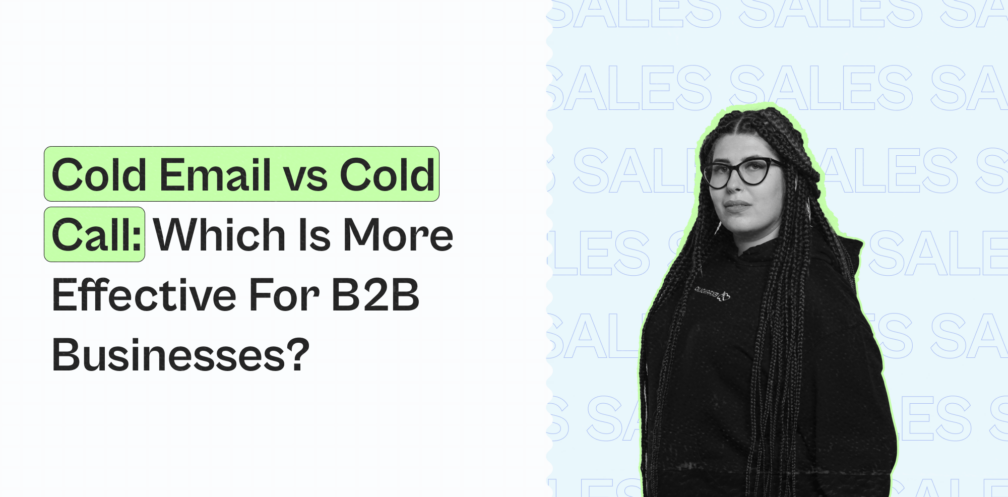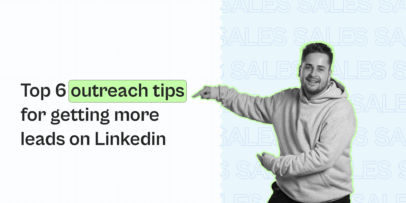Cold Email vs Cold Call: Which is More Effective? – Expandi

Cold emailing vs cold calling?
This modern dilemma is often faced by marketers and salespeople alike these days.
Both outreach channels have proven results in their own right when prospecting.
Cold emails are generally more manageable and less time-consuming.
Meanwhile, cold calls are more effective at directly gathering a direct response from the prospect.
But if you’re wondering if it’s better to call or email your prospects, the short answer is:
It depends…
However, if you’re also using LinkedIn as your mean lead generation and B2B outreach channel, you can use the synergy of cold calling and cold emailing to break the ice and get on your prospects’ radar.
First, let’s examine the state of prospecting in 2024 as far as LinkedIn outreach goes.
Then, we’ll show you all the tips and tricks on making the most out of the platform, whether you’ll be using cold emailing or cold calling. Or both!
Here’s what you’ll learn:
- LinkedIn Outreach Overview For B2B Businesses
- Cold calling VS Cold Emailing Breakdown: Pros And Cons
- How To Decide Between Cold Email and Cold Calling

LinkedIn Outreach Overview For B2B Businesses
Here’s a quick catch-up with what’s been going on with LinkedIn, if you’re not yet familiar:
- It’s the #1 channel for B2B marketers to distribute content and generate leads. 40% of monthly active users use LinkedIn daily and 79% of B2B marketers use it for generating leads (Source).
- You can use LinkedIn Sales Navigator to filter for your target audience based on job title, location, industry, and more.
- But with the new LinkedIn connections limit, you can only connect to up to 80-100 people per week.
So, before we discuss the effectiveness of cold calling vs cold emailing, let’s first look at the best methods to bypass the limits and find your target audience on the channel.
Bypassing LinkedIn limits
Now, if you’re considering between cold email and cold calling, you shouldn’t leave LinkedIn out of the equation.
It’s one of the best places to find your target audience, especially if running a B2B business.
And whether you decide to send a cold email or call your prospects, it’s still a good idea to establish the first touchpoint on LinkedIn.
To do that, you’ll want to be able to connect with more than 100 contacts per week.
Here’s a quick recap of how that works:
- Re-optimize your LinkedIn profile based on your target audience.
- Boost your LinkedIn Social Selling Index to strengthen your profile.
- Warm-up your LinkedIn account with the right automation tool.
- Follow our InMails Playbook guide to book more calls and reach more people through open InMails.
- Use an omnichannel customer experience strategy to get your prospects on email and LinkedIn (which you can further add phone calls to as an extra step).
Let’s zoom in on the last step more specifically because it’s arguably the most of the sequence.
Omnichannel B2B outreach
An omnichannel outreach strategy is a great way to increase your prospects’ chances of getting a response.
It accomplishes two main things:
- Gives you more chances to be seen through multiple touchpoints.
- Provides a more unified experience for your leads to remember you in your outreach.
Say you find a qualified lead on LinkedIn, your omnichannel outreach might have the following steps:
- You send an InMail message first, followed by an automated connection request.
- You then send an email outreach sequence with a solid hook to remind them about the LinkedIn request.
- Then, you continue with automated LinkedIn messages, which you can alternate with other channel messages, so you stay on top of your leads’ minds.
The four main focus areas of multi-channel outreach marketing are as follows:
- Target audience – This is very client-focused and contextual. Consider your ideal customer profile (ICP) and how you can find them on LinkedIn.
- Content – What kind of content resonates with your audience best? Take into consideration which stage of the marketing funnel your leads are in and what type of funnel content will work best.
- Personalization – For this, you’ll want to go beyond simple first and last name personalization. Something so specific it wouldn’t work with any other leads.
- Medium – Every marketing channel is different. Ideally, you should know which channels your audience is at and the best practices for each medium.
We’ll come back to omnichannel sales outreach again below and how to utilize cold email and calls.
But for now, let’s get back on topic and discuss cold email vs cold calling.
Cold calling VS Cold Emailing Breakdown: Pros And Cons
So, both phone and email marketing can be effectively used to initiate conversations with potential customers.
Both of them have the same objective: Starting conversations with potential clients.
Before we discuss the pros and cons of each, though, let’s take a look at some outreach concepts you should know about.
Cold calling overview
Don’t worry, cold calling isn’t like how it was before.
With better tech and marketing tools, it’s much more efficient to cold call than ever.
Here are some things to keep in mind:
- Auto dialing – Instead of manually calling prospects one by one, your sales reps can reduce downtime between calls and increase their overall productivity through auto-dialing. They offer value in other ways, such as integrating your tool with your CRM, so all contacts, records, and info are in one single place.
- Call recording – Sales dialers often have other features, such as call recording, which is the functionality to record calls for valuable information and feedback. Depending on your location or country, you might only need consent from one of the persons participating in a call to record it.
- VoIP – This simply means voice over internet protocol, allowing you to call or message your customers via phone call, app, or desktop.
If you’re wondering where to start with cold calling, you should know what many sales dialer software offers the above features and more.
And finding someone’s phone number isn’t as complicated as you might think.
Cold emailing overview
Cold emailing is more straightforward and the norm for many B2B and SaaS businesses.
Let’s quickly go over some essential concepts and metrics for email:
- Email warmup – You’ll want to do this first to boost your email deliverability and how many emails you can send per day. Fortunately, this is pretty straightforward and automated with the right tool. Check out our full article for more info on this.
- MQL to SQL conversion rate – How many of your marketing-qualified leads become sales-qualified leads.
- Outreach sales metrics – Email open rates, LinkedIn connection request acceptance, reply rate, follow-ups, links clicked, etc.
Now that you have an idea of how these outreach sales tactics work let’s look at some of their advantages and disadvantages.
Cold calling pros and cons
Cold calling has been around since the telephone. It’s a technique where a sales development rep usually calls individuals (potential customers) to share their sales pitch.
It’s inappropriate for every business and can be challenging to execute correctly.
Here’s an overview.
Cold calling pros:
- They’re much more personal, especially compared to a cold email.
- They give a faster response, whether a ‘yes’ or a ‘no.
- You can deal with a ‘No’ immediately and find more information about your target audience.
- You have a one-on-one conversation and explore more opportunities, depending on the prospect.
Cold calling cons:
- Cold calling has a bad reputation.
- You can frustrate your prospects if you haven’t done your research correctly.
- They’re traditionally more complicated and more time-consuming.
- Prospect’s numbers are harder to find compared to an email.
Cold emails pros and cons
We’ve covered email outreach before, but let’s take a look at the pros and cons more specifically below.
Cold emailing pros:
- Much easier to scale with the right software.
- Easier to distribute and track the analytics.
- Cold emails are cheaper and more time-efficient.
- Emails are less frustrating and time-consuming both for the sender and recipient.
Cold emailing cons:
- Much easier for prospects to ignore your message.
- Cold emails don’t give immediate responses or feedback.
- Some cold emails are never opened or read.
- Your prospects get a lot of emails and you need to stand out, especially if you’re a B2B business.
Now, the question on everyone’s mind…
How To Decide Between Cold Email and Cold Calling
Saying it would depend on your business might feel like a cop-out answer.
So, instead, let’s take a look at some guidelines you’ll want to take into consideration when deciding between cold emailing or cold calling.
- What is your buyer persona like – A lot depends on the industry in the first place. Cold calling is especially common in the insurance, financial, and other high-touch or expensive offering niches. First, ask around or find out if cold calling is common in your industry. Try to find out if your competitors are focusing on this or a potential opportunity.
- What is the level of your prospect – Does the individual you’re contacting have an assistant? C-level executives almost always do. The higher person you’re trying to get in an organization, the more likely you will reach a gatekeeper. And in general, higher-level prospects are generally more comfortable on the phone and less intimidated by sales calls.
- What is the ask – What is the objective of your first outreach? Do you want to set up a meeting, get more info, receive a referral, or something else? “Strong” asks usually require a commitment for the prospect to do something. But if the ask is “weak”, you can probably get that info out of them with a simple email.
- The time and day of the week – A person is more likely to answer their phone later in the workday and workweek. Meanwhile, they’re more likely to answer an email if it’s the first thing they see when they’re just getting ready to work or if they’re scrolling on their phone between work. Fortunately, you can schedule your emails to get sent around 9-10 AM and block out chunks of time on your calendar for cold calling.
Now, if you’re still stuck between deciding to send cold email campaigns or picking up the phone yourself, you should consider doing both.
While keeping track of all the data and analytics to decide if it’s worth focusing on cold email or cold calling full-time instead.

With the right combination of sales and marketing tech stack, it’s easier than ever to provide an omnichannel outreach experience.
This simply means targeting your prospects on most (if not all) channels.
So, for example, a potential flow might look like this:
- Starting with a cold call asking your prospect if they’d be interested in your value proposition so you can send it over with more info on LinkedIn or email.
- An automated LinkedIn connection or an email mentioning that you called or left a voice recording on their phone.
- An automated follow-up (on LinkedIn if you sent an email first, or vice-versa).
- Automated LinkedIn InMial or hyper-personalized email to skyrocket your reply rate.
- Another automated follow-up to remind them about yourself on any platform of your choice.
As you can see, there are a lot of opportunities here to stay on top of your prospects’ minds as well as follow up, all on autopilot.
And with hyper-personalized GIFs like the one you see below, which is also automated, you’re more likely to get a reply as it humanizes your approach.

Conclusion
Now, let’s sum up cold emailing vs cold calling:
- Is cold emailing better than cold calling?
Both cold emailing and cold calling are effective for sales prospecting. From a technical standpoint, the main difference has to do with the matter of volume (scalability) and convenience versus directness. Cold emails are generally easier and less time-consuming to scale – hence it being the norm for many B2B businesses out there. However, cold calls can be more effective at gaining a direct response from a lead.
- Should you cold call or cold email first?
This also depends on your outreach objective and your “ask”. But as a generalization, it might be more advisable to email first as it doesn’t require the prospect to answer the moment they receive the message. And then, you can follow up with a cold call. Then, the prospect might feel obligated to reply or give you more of their time once you remind them of the initial email.
- Is it better to email or call a prospect?
While it depends on the industry and the prospect level or position, a cold call is more likely to initiate a conversation than sending an email. It lets you get to know the prospect, and even if they say “No”, you’re more likely to learn the reason than from an email. As a rule of thumb, though, you should consider doing both and see what works better based on data!
- What is the email equivalent of a cold call?
The email equivalent of a cold call is a cold email. Cold emailing is a type of email marketing and differs from transactional or warm emailing. The unsolicited email is sent without a prior contract and usually, the objective is to establish a relationship or book a meeting.
Ready to launch your next sales outreach campaign on email and LinkedIn?
Get started with a live demo or a free, 7-day Expandi trial to automate your sales outreach now!
You’ve made it all the way down here, take the final step


